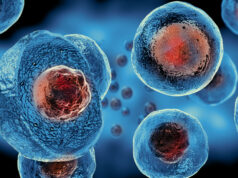
Xintela’s CEO on successful studies and approved GMP facility
May has been an eventful month for Xintela with a steady stream of good news, including positive preclinical results that show that the company’s stem cell product XSTEM repairs damaged cartilage in an animal model and has great potential to become a so-called DMOAD (disease modifying osteoarthritis drug). Shortly after that, Xintela announced that it had chosen difficult-to-heal (chronic) wounds as a new indication, and that XSTEM had already shown excellent wound healing ability in a preclinical wound model. More recently, Xintela also received permission from the Medical Products Agency to produce cell therapy products in its own GMP facility, which means that production of XSTEM will now begin for clinical studies.
 The key to Xintela’s business is the XINMARK marker technology, which is based on specific cell surface proteins (integrins) that work as markers located on the surface of key cell types, including stem cells. With the help of its marker technology, Xintela can therefore select and quality-assure stem cells, something that the company benefits from in the development of its stem cell therapy products under the name XSTEM.
The key to Xintela’s business is the XINMARK marker technology, which is based on specific cell surface proteins (integrins) that work as markers located on the surface of key cell types, including stem cells. With the help of its marker technology, Xintela can therefore select and quality-assure stem cells, something that the company benefits from in the development of its stem cell therapy products under the name XSTEM.
Xintela envisions several treatment areas for XSTEM, including the joint disease osteoarthritis, and now the company has announced that they also plan to target difficult-to-heal wounds, also know as chronic wounds. Difficult-to-heal wounds are a major medical problem that causes a great deal of pain and suffering for the patient. The risk increases with the patient’s age and there are few effective treatment methods. This not only means a deteriorating quality of life for patients, but also large societal costs. The condition is estimated to account for as much as 2–4 per cent of the total health care costs in Sweden. The global market for wound care for difficult-to-heal wounds is extensive and was estimated at 10.12 BUSD in 2019 with an expected increase to 16.36 BUSD in 2027 according to a report from Fortune Business Insights.
XSTEM demonstrates wound healing capability in wound model
Xintela have now made the choice to address the problems of difficult-to-heal wounds with its XSTEM stem cell product. Recently, the company showed that XSTEM provides excellent healing of wounds in a pig model and that the newly-formed skin tissue resembles normal skin. In addition, XSTEM shows signs of less scarring compared to transplanted skin cells.
The promising results were produced in collaboration with Professor Folke Sjöberg and his research team at the Burn Center atLinköping University Hospital. In a press release from Xintela, Sjöberg says that he is impressed with the results and the stem cell product’s healing potential. In addition, he believes that Xintela’s stem cell product is interesting as it can potentially handle many wound healing functions. Xintela and the Linköping team are now planning clinical trials with XSTEM in patients with difficult-to-heal wounds. Clinical trials for difficult-to-heal wounds can be completed in a relatively short time, making a quick path to the market for Xintela possible.
XSTEM repairs joint cartilage damage in preclinical model
Recently, Xintela also presented further evidence of the potential in osteoarthritis as studies in an animal model of joint cartilage damage showed that XSTEM directly contributes to repairing the damage and regenerating cartilage. The company explains that when the stem cells are injected into the damaged joint, they home to the cartilage damage and contribute to repairing the cartilage damage by differentiating into cartilage cells and producing new cartilage tissue.
The preclinical study was conducted in collaboration with Professor Casper Lindegaard and his research group at the Department of Clinical Veterinary Medicine at the University of Copenhagen. Parts of the results were recently presented during the Osteoarthritis Conference OARSI (Osteoarthritis Research Society International) and are now being prepared in their entirety for publication in a scientific journal.
XSTEM is a potential DMOAD
The results from the studies in Copenhagen indicate that Xintela’s stem cell treatment can function as a DMOAD (Disease Modifying Osteoarthritis Drug), i.e., a treatment that can inhibit/reverse the development of osteoarthritis by preventing degradation of the cartilage and possibly also regenerating the cartilage. There are currently no approved DMOADs on the market, which means that there is a large market potential for XSTEM for the treatment of osteoarthritis. Xintela plans to initiate clinical trials with XSTEM on knee osteoarthritis patients during this year.
Approval for GMP production of cell therapy products
Recently, Xintela also announced that the company has received permission from the Medical Products Agency to produce cell therapy products, so-called Advanced Therapeutic Medical Products (ATMPs), in the company’s own GMP facility. This is a major milestone for the company and means that Xintela can now start producing XSTEM for its planned clinical studies. There are se
Xintela’s CEO comments

BioStock contacted Xintela’s CEO Evy Lundgren-Åkerlund to get her take on the positive news flow.
Why did you decide to include difficult-to-heal wounds in your development programme?
– The results of the wound healing study that we conducted together with Prof Folke Sjöberg and his team are very convincing and show great potential for XSTEM in wound healing and other skin-related complications. The need for better treatment options for patients with difficult-to-heal wounds is great and we also see that the market for wound healing is significant.
How come you chose to collaborate with the Burn Center in Linköping?
– Professor Folke Sjöberg is a world authority in burns. He and his team also have a lot of experience in both preclinical and clinical studies linked to wound healing and we have established a very good and rewarding collaboration.
Can you say something about when and where you plan to start clinical trials with XSTEM in patients with difficult-to-heal wounds?
– We will return with further information a little later.
You have also produced promising preclinical results in osteoarthritis that indicate that XSTEM is a DMOAD. Is the ultimate goal to become one of the first DMOADs to reach the market?
– Based on the convincing preclinical results we have obtained, I believe that XSTEM has very good chances of becoming a DMOAD. A DMOAD has the potential to slow down the breakdown of cartilage and, at best, cure osteoarthritis. As there is no approved DMOAD yet, there is a potentially very large market waiting for XSTEM.
»As there is no approved DMOAD yet, there is a potentially very large market waiting for XSTEM.«
With the manufacturing permit in place, you can start producing XSTEM in your GMP facility. What are the advantages of having your own production facility compared to contract manufacturing with external parties?
– Of course, the fact that we ourselves can completely control the production of XSTEM has great advantages both in terms of planning and finances. In addition, today there is a global shortage of capacity for the manufacture of cell therapy products, which has become a difficult bottleneck for companies that need to manufacture their cells for clinical studies and for commercial production. The knowledge in GMP production of cell therapy products that we have now built up in the team, we also have the opportunity to use in the future for contract manufacturing for other companies, which adds extra value for Xintela.
The content of BioStock’s news and analyses is independent but the work of BioStock is to a certain degree financed by life science companies. The above article concerns a company from which BioStock has received financing.


